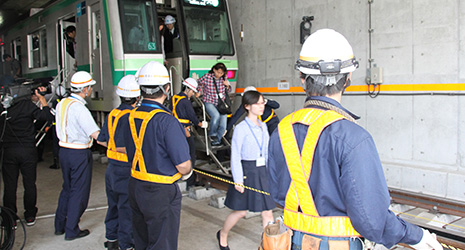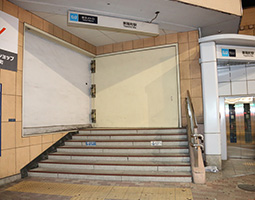Home > Highlighting JAPAN > Highlighting Japan March 2018 > Technologies for Disaster Mitigation
Highlighting JAPAN


Safety on the Tokyo Underground
Tokyo’s main subway company has introduced a wide range of measures to protect both the infrastructure and rail line users in the event of natural disasters.
Since the first subway in Asia opened in Tokyo in 1927, the subway lines have continued to expand. Currently, thirteen lines extending over 304 kilometers support users in Tokyo. Tokyo Metro Co., Ltd. (hereafter Tokyo Metro), which manages the main lines, runs nine lines (179 stations, 195 kilometers), and more than 7.2 million people use these lines every day. In addition, seven lines are directly connected to lines operated by other railway companies that stretch to the suburbs of Tokyo.
Takeshi Machida, who belongs to the Safety Affairs Department of Tokyo Metro, says, “Because subways are important infrastructure that support the traffic in Tokyo, safe and stable operations are essential. We promote measures for preventing damage in the event of natural disasters and achieving the rapid resumption of operations.”
Tokyo Metro is particularly focused on earthquakes and submersion in its measures for natural disasters. The Great Hanshin-Awaji Earthquake in 1995 caused major damage to structures including viaducts and columns in subway tunnels in the Keihanshin (Kyoto, Osaka and Kobe) area. In response to this, Tokyo Metro undertook earthquake-resistant reinforcement construction work to prevent similar damage in the event of earthquakes in Tokyo. Although Tokyo was not badly affected by the Great East Japan Earthquake in 2011, Tokyo Metro is also undertaking additional earthquake-resistant reinforcement construction work in preparation for major earthquakes that occur directly under the city.
In addition, Tokyo Metro operates two earthquake alert systems for emergency subway stops at the same time in preparation for the occurrence of a major earthquake while the trains are running system. In one system, seismometers in six locations along subway lines predict or measure large shakes that exceed a particular level. In the other system, Earthquake Early Warnings sent by the Japan Meteorological Agency (JMA) are received.
Machida says, “When the Great East Japan Earthquake occurred, we received Earthquake Early Warnings sent by the JMA before the huge shakes occurred in Tokyo and were able to implement emergency stops of the 170 trains on all the lines. We then conducted safety inspections of all the lines and gradually resumed operations about six hours after the earthquake.”
Because the Great East Japan Earthquake occurred at 2:46 p.m., the subsequent interruption of subway operations meant many people in Tokyo found it difficult to get home. Learning from this experience, Tokyo Metro has prepared and distributed for about 100,000 people who would have difficulty getting home emergency drinking water, along with aluminum blankets, simple mats and portable toilets, to individual stations. In addition, Tokyo Metro has installed digital displays in Japanese, English, Chinese and Korean near the ticket gates at all stations, and provides information about accidents and disasters to users. Tokyo Metro has also strengthened the circulation of information using websites and Twitter.
Earthquakes are not the only natural disaster that will affect subway traffic. Tokyo Metro has made preparations for natural disasters by, for example, installing boards to stop the flow of water of up to 105 centimeters at the entrances and exits of subways above ground to prevent submersion inside subways caused by high tides, heavy rains and the overflowing of rivers. In addition, Tokyo Metro has also raised the entrances and exits of stations to positions higher than the sidewalks in zones where there are greater risks of floods, and has installed doors to prevent the inflow of water that could block entire entrances and exits. Tokyo Metro has also installed remote-controlled devices for preventing submersion, which can endure submersion of up to six meters, at vents installed on the sidewalks in an effort to secure full preparedness for natural disasters.
In addition to hardware-based measures, such as systems and devices, Tokyo Metro also has conducted various drills for the station attendants and crew on how to act in the event of disasters. The Comprehensive Learning and Training Center, which undertakes the training of the crew, has facilities such as simulation stations equipped with the same facilities as the actual stations, operation exercise lines where training trains run in tunnels, and simulators that enable operation training that is almost equivalent to real trains. The Center provides practical training about how to act in the event of accidents and disasters.
Machida says, “Tokyo has always experienced various natural disasters. But fortunately, we have not had any subway accidents involving multiple casualties caused directly by a natural disaster. We will continue to implement the maximum possible measures to secure subway high safety.”
Tokyo Metro plans to further strengthen its cooperation with organizations including other public transport operators, local governments, police stations and fire stations, and community residents to prepare for major disasters.
© 2009 Cabinet Office, Government of Japan








